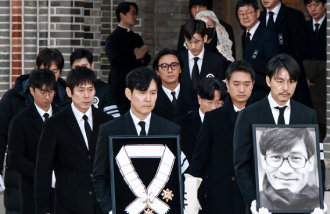Bottle Entrances are Golden
Bottle Entrances are Golden
Posted November. 22, 2005 08:34,
People first starting up a shop attempt to sign a contract if the floating population is about 20,000. But one shouldnt be fooled by the size of the floating population. (Family Mart, Min Seung-bae, division chief, 35)
One must first see how stable the sales will be rather than focusing on high revenues. (GS Retail Chang Jun-soo, division chief, 36)
Min and Chang have an eye for shopping centers. They say they know what location will make money. Their extraordinary talent makes them enviable to self-employed people and shopping center investors.
Chang is the division chief at GS Retails Convenience Store Division, Development Team 5, and Min is the division chief at Family Mart Sales Division 1, Gangnam Development Team. They are both experts on store development. They have been visiting shopping areas for over 10 years. Chang and Min started looking for places to open stores in 1995, and since then, have opened 250 and 210 stores, respectively.
Find the Golden Location
On the afternoon of November 18 at a shopping center near the subway station in Seongnam, Gyeonggi Province. Chang pointed at a fruit shop and said that the location would be good for a convenience store.
There is an apartment complex with 840 units behind the store, and the people pass by the fruit shop to go to the subway station. This type of location is called a bottle entrance because it is suitable for shopping centers.
Chang explained that bakeries, ice cream parlors, and stationery stores are also suitable at locations ideal for a convenience store.
He also emphasized that it is important to check the foot traffic patterns before selecting a place for a convenience store or bakery. Chang added that it should be checked at least three times a day- during the rush hours and the lunch hour. There is no guarantee that many people will pass along a large street.
To check the foot traffic in person, one can go up to the rooftop of a nearby building.
Chang has succeeded in opening a convenience store at a neighborhood where many women working at bars lived. Although sales were low during the day, the store was profitable because of the strong sales between 3:00 4:00 a.m. He explained that he succeeded because he was able to capitalize on the high levels of foot traffic at specific hours of the day.
Min stressed the importance of the number of households within the radius of the store. He counts the number of electric gauges, water meters, and mailboxes to correctly assess the number of households. He was even taken to the police station while counting at night.
Be Wary of Sale Prices
Most shopping center owners will exaggerate the revenues of stores. For them, selling the store is what is important.
Store prices change often, so one should be careful when concluding a contract, the experts advise.
Chang said, This time last year, a shopping center in Yongin, Gyeonggi Province, was rented out at 3-4 million won per month with a deposit of 100 million won (area 15~20 pyeong). But now, the monthly rent is 2-2.5 million won with a deposit of 50 million won. Prices will drop at shopping centers if the stores in them are not profitable.
The rent at shopping centers that are about two years old are fixed at the market price, so start-ups will probably not end up paying overly-inflated prices, Min pointed out.
However, start-up owners are easily fooled by the floating population.
Min said, Your real customers will only be about two percent of the floating population, at most. But since the rent at locations with high levels of floating population will be expensive, it may end up being unprofitable.
Both experts said, It is essential to find out the revenues of a nearby store which is similar in size before signing the contract.
Jin-Suk Huh jameshuh@donga.com




![지하철 타고 가는 북한산성…외국인도 반한 ‘K등산 맛집’[전승훈 기자의 아트로드]](https://dimg.donga.com/c/138/175/90/1/wps/NEWS/IMAGE/2026/01/10/133120824.1.jpg)


